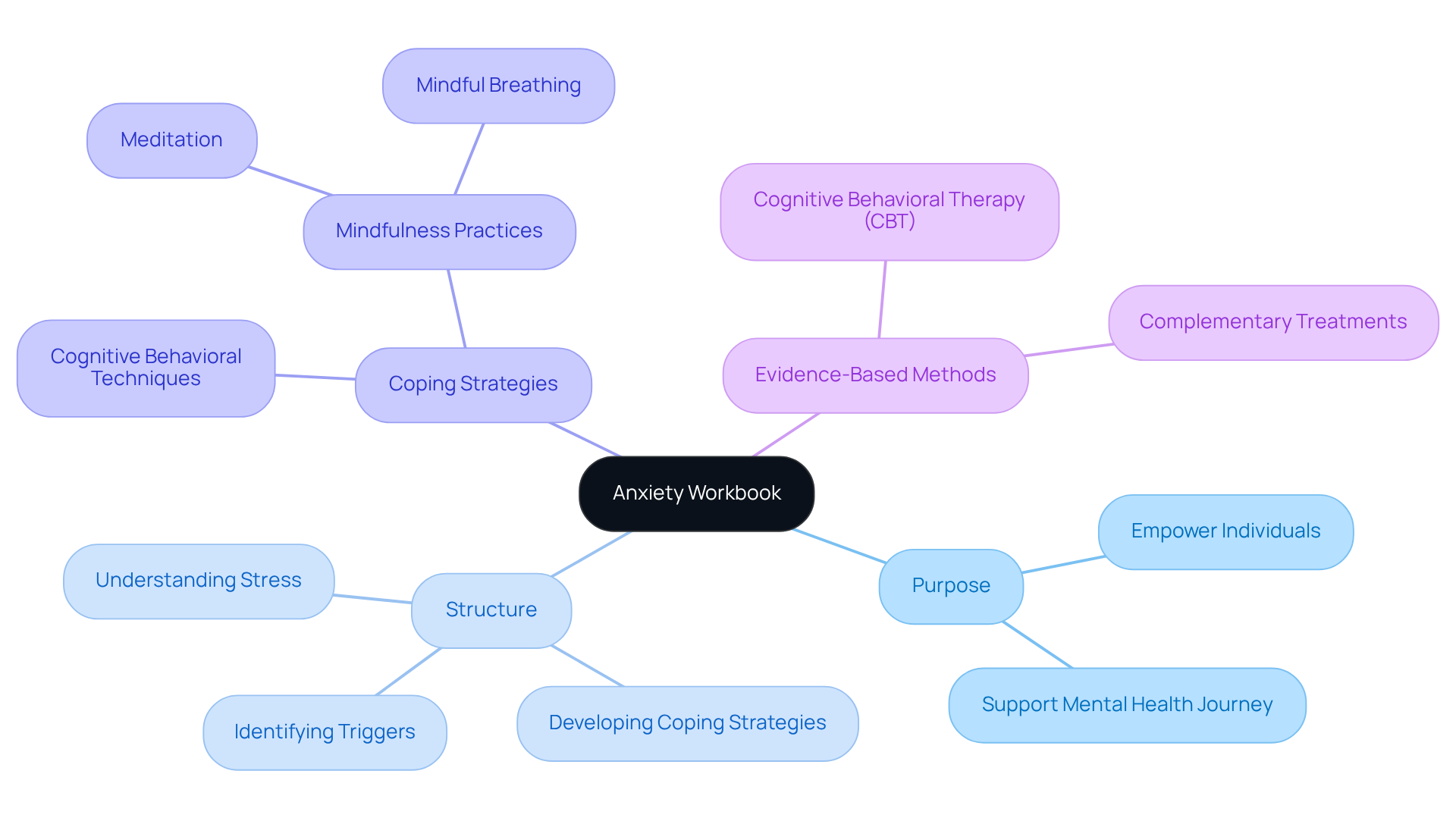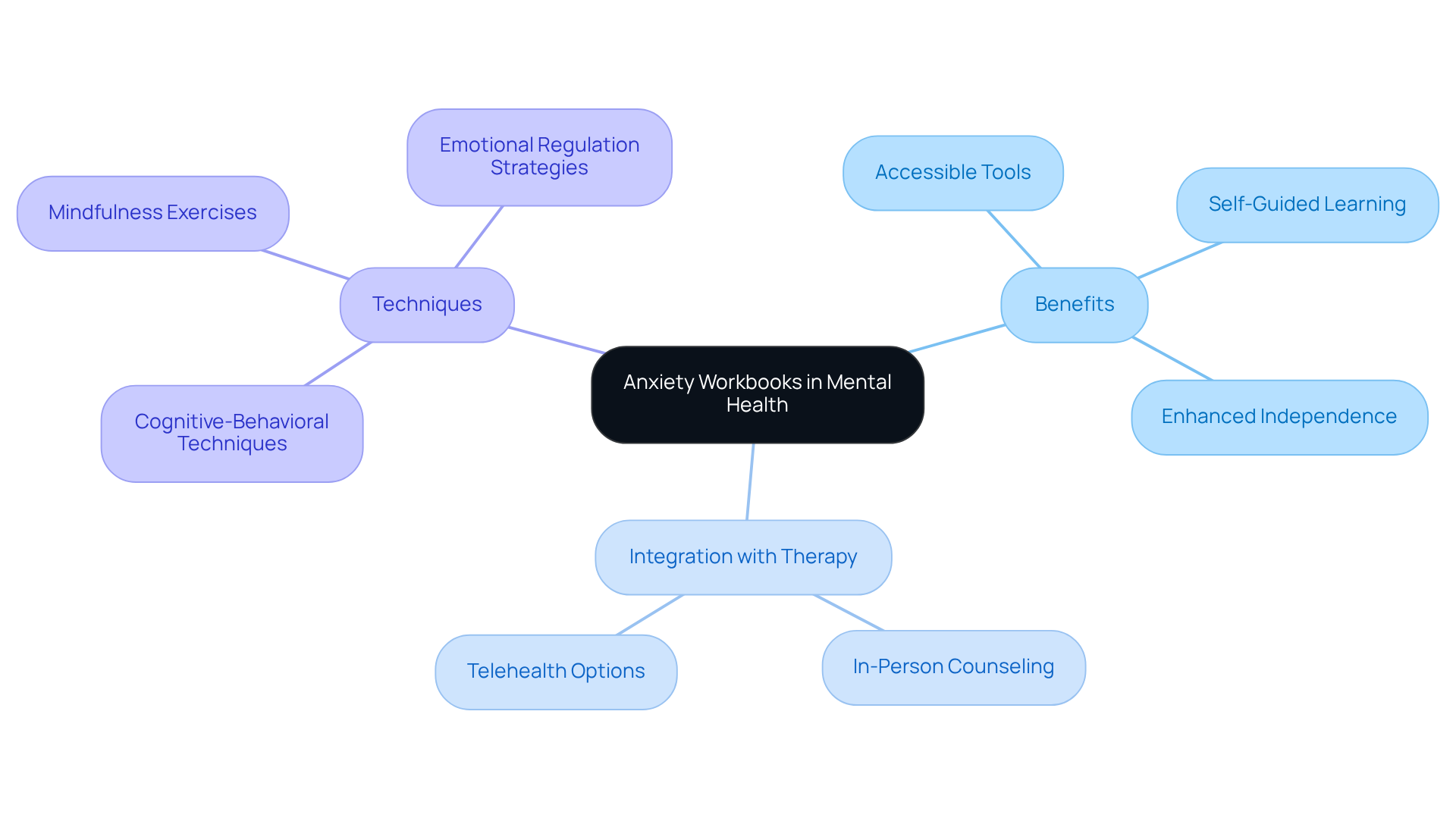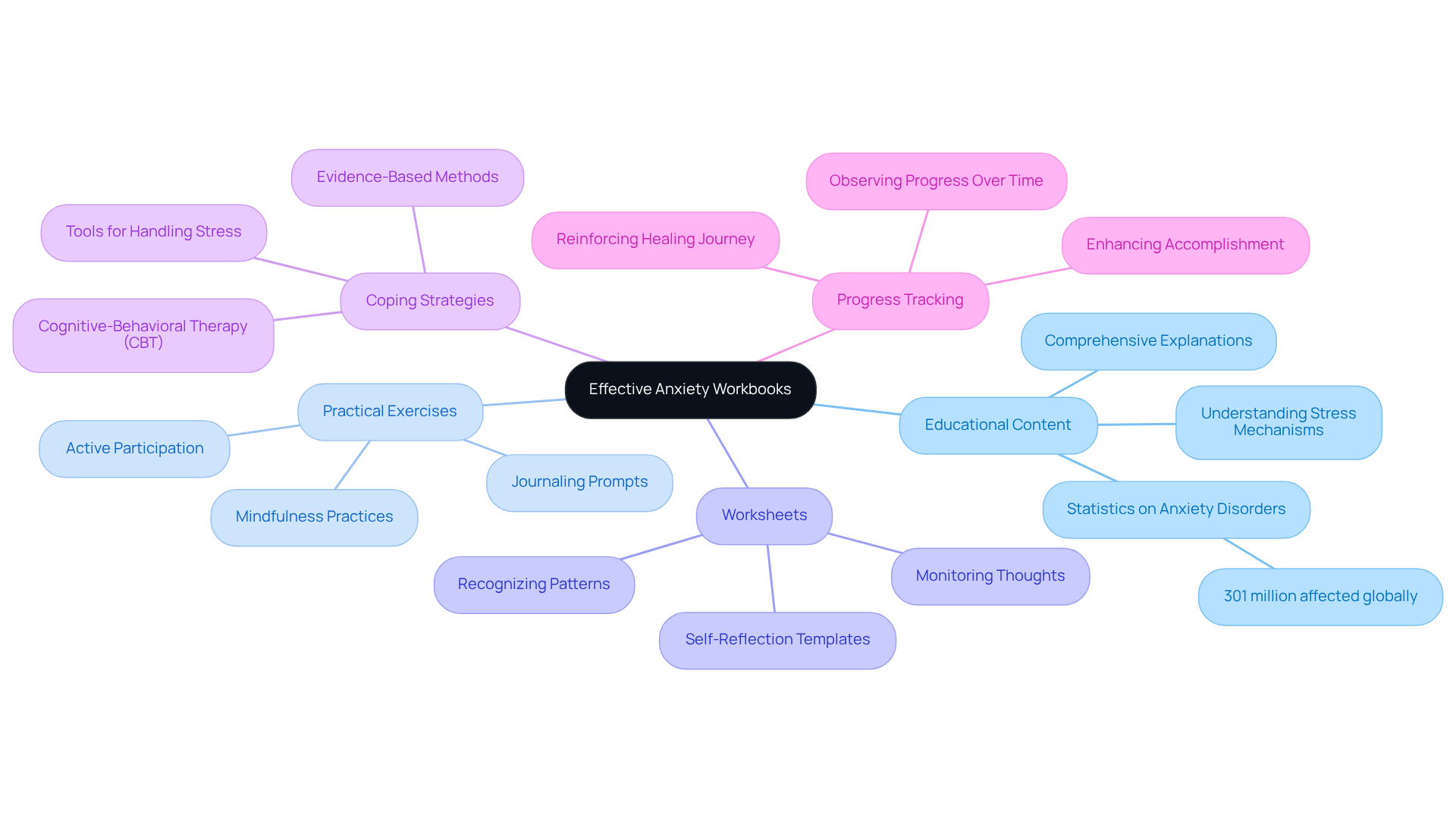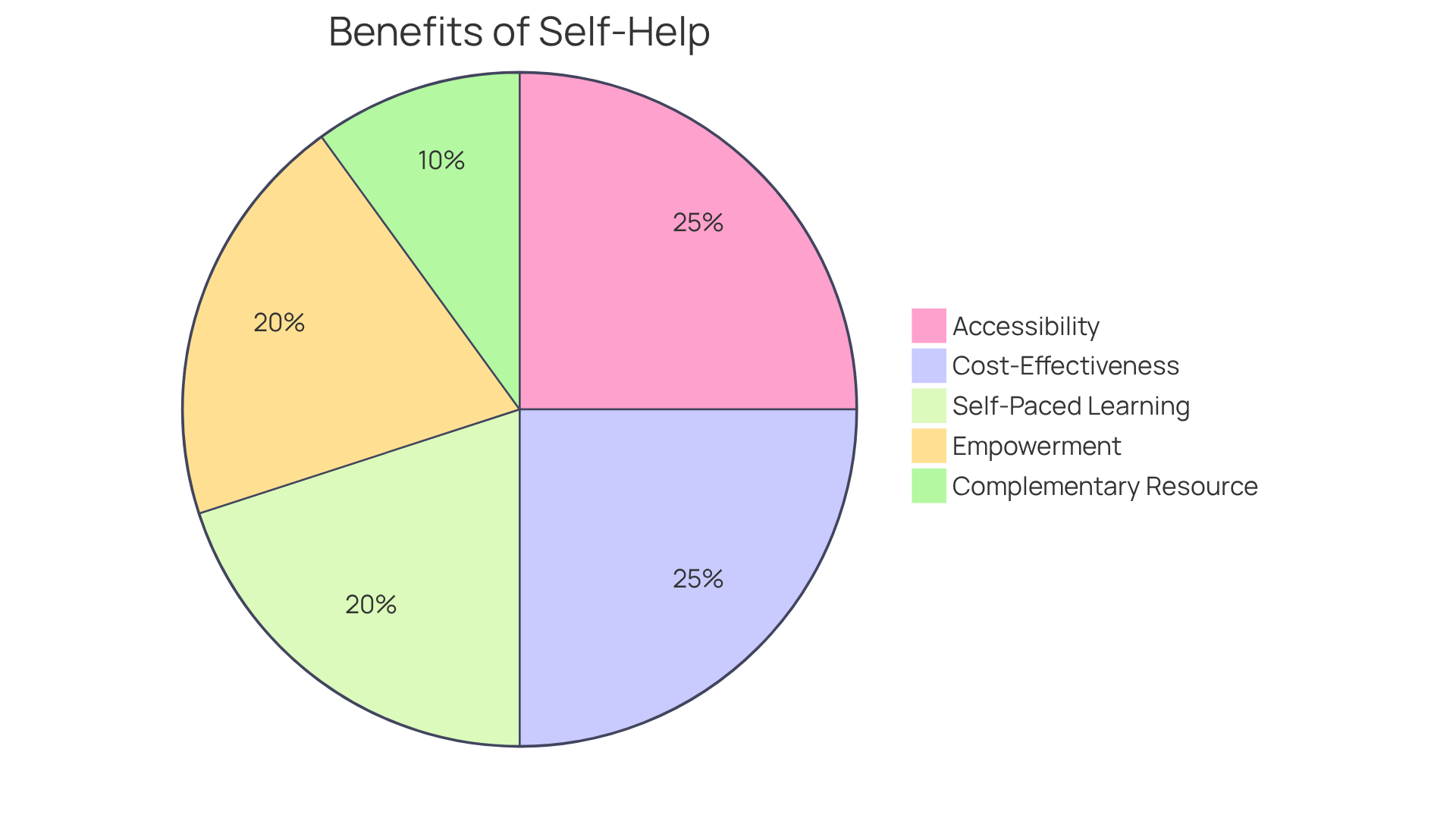Overview
The article highlights the essential components and benefits of anxiety workbooks, which serve as invaluable self-help resources for individuals navigating anxiety and stress. These workbooks combine educational content with practical exercises, allowing users to cultivate coping strategies and enhance their mental well-being. Grounded in evidence-based methods, such as cognitive-behavioral therapy (CBT), they offer a compassionate approach to healing.
Have you ever felt overwhelmed by your past? This is where anxiety workbooks can truly make a difference, guiding you on a journey toward understanding and managing your emotions. As we explore this further, consider how these resources can empower you to take control of your mental health and foster a sense of peace in your life.
Introduction
Anxiety affects millions, often leaving individuals feeling overwhelmed and isolated in their struggles. Have you ever felt this way? Anxiety workbooks emerge as vital tools in this landscape, offering structured guidance that blends educational insights with practical exercises aimed at fostering resilience and self-awareness. As we explore this further, it’s essential to understand how these resources can transform the journey of managing anxiety.
What key components make them effective? Exploring the multifaceted benefits of anxiety workbooks reveals not only their role in personal development but also their potential to complement traditional therapeutic approaches. This invites individuals to take charge of their mental health like never before, empowering them on their path to healing.
Define Anxiety Workbook: Purpose and Structure
An anxiety workbook serves as a compassionate resource designed to help individuals navigate and understand their anxiety symptoms. These guides typically blend educational material with practical activities, providing sheets that support users in exploring various coping methods found in an anxiety workbook, including mindfulness practices like meditation and mindful breathing. The primary aim is to empower individuals to take an active role in their mental health journey, offering a self-help resource that fosters personal growth and resilience.
The structure of an anxiety workbook often includes sections that cover fundamental topics such as understanding stress, identifying triggers, and developing effective coping strategies. Mindfulness practices are woven into these sections to enhance emotional regulation and awareness, allowing individuals to slow down and observe their thoughts without judgment. This holistic approach ensures that users can navigate their distress more effectively while cultivating a deeper connection to their thoughts and feelings.
Evidence-based methods, particularly cognitive-behavioral therapy (CBT), are frequently integrated into the anxiety workbook, enhancing its effectiveness in promoting psychological well-being. Have you ever felt overwhelmed by your past? Studies indicate that many individuals turn to self-help guides for personal development, highlighting a growing movement towards self-directed emotional wellness management. The benefits of these resources are manifold; they not only provide practical tools for managing stress but also encourage a deeper understanding of one’s psychological state. Specialist perspectives underscore the value of self-help guides in therapeutic settings, suggesting they can complement traditional treatment methods and improve overall outcomes. By engaging with these resources, individuals can nurture resilience and develop healthier coping strategies, making these guides invaluable tools on the path to psychological well-being.

Contextualize the Role of Anxiety Workbooks in Mental Health
Anxiety workbooks are invaluable resources in the mental health field, providing accessible tools for individuals facing stress. These manuals are designed to complement therapy at The Emerald Couch, which provides both in-person counseling and telehealth options. This flexibility allows clients to deepen the insights gained during their sessions. They are particularly beneficial for those who may not have immediate access to a therapist or who prefer a self-guided approach. By presenting structured activities and educational material, an anxiety workbook empowers individuals to explore their emotions, recognize patterns, and cultivate coping strategies at their own pace.
This combination of expert guidance and self-directed learning not only enhances the effectiveness of stress management but also fosters a sense of independence and resilience in those navigating their wellness journeys. Mental health professionals at The Emerald Couch emphasize that self-directed resources can significantly impact stress management, as they encourage proactive engagement with one’s mental well-being. Have you ever felt overwhelmed by your past? Self-help guides, like an anxiety workbook, can enrich therapy sessions by allowing clients to practice the skills learned in treatment, thereby reinforcing their therapeutic progress.
Examples of effective stress management guides include those that focus on:
- Cognitive-behavioral techniques
- Mindfulness exercises
- Emotional regulation strategies
These approaches can be seamlessly integrated into a holistic treatment plan tailored to individual needs, addressing challenges such as trauma, PTSD, OCD, and phobias. As we explore these resources, remember that seeking help is a brave step towards healing and well-being.

Identify Key Components of Effective Anxiety Workbooks
Effective anxiety workbooks for stress management are thoughtfully designed with several key components that significantly enhance their utility for users. These components include:
-
Educational Content: Comprehensive explanations of stress, its symptoms, and underlying mechanisms are crucial for helping users understand their experiences. This fundamental understanding is essential, especially considering that stress-related disorders impact around 301 million individuals worldwide. Accessible information is truly necessary in this context.
-
Practical Exercises: Engaging activities, such as journaling prompts and mindfulness practices, encourage users to apply concepts in real-life situations. These exercises foster active participation in their healing process, nurturing a sense of empowerment.
-
Worksheets: Organized templates for monitoring thoughts, feelings, and behaviors promote self-reflection and awareness. This enables users to recognize patterns and triggers in their distress, guiding them gently toward understanding their emotional landscape.
-
Coping Strategies: Evidence-based methods, particularly those developed from cognitive-behavioral therapy (CBT), provide users with effective resources to handle stress. These strategies are vital, as research indicates that only approximately 43.2% of adults with generalized stress disorder receive treatment. Having these tools at hand can make a significant difference.
-
Progress Tracking: Sections focused on observing progress over time enhance a feeling of accomplishment and drive. This is vital for individuals facing the challenges of stress, as it reinforces their journey toward healing.
By including these components, stress guides evolve into thorough tools that empower people on their path to effectively managing their worries. The significance of educational material in these resources, particularly in an anxiety workbook, cannot be overstated, as it establishes the foundation for comprehending and tackling anxiety-related disorders—some of the most prevalent mental health issues globally. Have you ever felt overwhelmed by your past? Recognizing these feelings is a crucial step toward seeking the support you deserve.

Explore Benefits of Utilizing Anxiety Workbooks for Management
Using self-help guides offers numerous advantages for individuals seeking to manage their stress signals, especially for high achievers who often feel overwhelmed. These benefits include:
-
Accessibility: Available in both print and digital formats, these resources can be accessed anytime, making them incredibly convenient. Many high achievers face barriers to traditional therapy, such as time constraints and the tendency to prioritize work or family over their own needs. This makes self-help guides particularly valuable for enhancing well-being.
-
Self-Paced Learning: Users can progress through the material at their own pace, allowing for a tailored approach to stress management. This flexibility is especially beneficial for those who may feel paralyzed by past trauma, as it provides the opportunity to engage with the content when they feel ready.
-
Empowerment: Engaging with these materials fosters a sense of control over one’s mental health, enhancing resilience and self-efficacy. For trauma survivors, this empowerment is vital in reclaiming their narrative and finding safety in their bodies and lives once again.
-
Cost-Effectiveness: Workbooks present a more affordable alternative to traditional therapy sessions, addressing the financial constraints many high achievers encounter. Research indicates that self-help treatments have shown greater effectiveness than control groups (waiting list, placebo, symptom monitoring) at post-treatment, with an effect size of d = 0.62 (SD=0.33).
-
Complementary Resource: These guides reinforce concepts learned in therapy, providing additional practice and support outside of sessions. This is essential for those navigating the complexities of stress and trauma.
Practical examples illustrate the impact of self-directed learning through stress management guides. Many individuals have reported improvements in their ability to cope with stress symptoms, highlighting the effectiveness of these tools in fostering self-management skills. For instance, endorsements from high achievers reveal that utilizing these resources has helped them regain control over their stress and prioritize their emotional well-being. A systematic review noted that self-help interventions were effective in reducing symptoms of distress, particularly for social phobia and panic disorder. By enhancing accessibility and offering structured guidance, an anxiety workbook empowers individuals to take charge of their mental health and develop effective coping strategies, aligning beautifully with The Emerald Couch's compassionate approach to therapy.

Conclusion
Anxiety workbooks are a vital resource for those looking to understand and manage their anxiety symptoms in a meaningful way. By blending educational content with practical exercises, these workbooks empower individuals to take charge of their mental health journey, fostering resilience and personal growth. This structured approach not only enhances self-awareness but also equips individuals with essential coping strategies rooted in evidence-based practices.
As we explore this further, key components such as educational material, practical exercises, and progress tracking emerge as critical elements that enhance the effectiveness of anxiety workbooks. These resources offer the tools necessary to navigate emotional landscapes, recognize triggers, and implement coping strategies that promote psychological well-being. The integration of mindfulness practices and cognitive-behavioral techniques further solidifies their role in supporting mental health.
Ultimately, anxiety workbooks serve as a powerful complement to traditional therapy, providing accessible, self-paced, and cost-effective solutions for managing stress and anxiety. Have you ever felt overwhelmed by your past? Engaging with these resources allows individuals not only to gain valuable insights into their mental health but also to cultivate a sense of empowerment and independence. Embracing the use of anxiety workbooks can be a transformative step towards achieving emotional well-being and resilience, underscoring the importance of self-directed support in the journey of mental health management.
Frequently Asked Questions
What is the purpose of an anxiety workbook?
An anxiety workbook serves as a compassionate resource to help individuals navigate and understand their anxiety symptoms, blending educational material with practical activities to empower users in their mental health journey.
What topics are typically covered in an anxiety workbook?
An anxiety workbook often includes sections on understanding stress, identifying triggers, and developing effective coping strategies, along with mindfulness practices to enhance emotional regulation and awareness.
How do mindfulness practices fit into an anxiety workbook?
Mindfulness practices, such as meditation and mindful breathing, are woven into the workbook's sections to help individuals slow down, observe their thoughts without judgment, and navigate their distress more effectively.
What therapeutic methods are commonly integrated into anxiety workbooks?
Evidence-based methods, particularly cognitive-behavioral therapy (CBT), are frequently included in anxiety workbooks to enhance their effectiveness in promoting psychological well-being.
How can anxiety workbooks benefit individuals?
Anxiety workbooks provide practical tools for managing stress, encourage a deeper understanding of one’s psychological state, and can complement traditional treatment methods, ultimately improving overall outcomes.
Why is there a growing movement towards self-help guides for emotional wellness?
Many individuals are turning to self-help guides for personal development, highlighting a trend towards self-directed emotional wellness management as a means to nurture resilience and develop healthier coping strategies.




